Gold plays an important role in an investment portfolio as it offers diversification benefits, protection against inflation or currency devaluation and is viewed as a safe-haven asset that is particularly relevant in times of high market volatility, political instability and financial or economic crises. Initially, gold was used as a form of art and then a medium of exchange (currency) that laid the foundation of modern monetary system. The discovery of gold treasures goes back to over few thousand years and since then it has been linked with the store of value, wealth, and power. Later when paper money was invented as as a medium of exchange, gold was used to back that paper currency, known as gold standard. Gold has finite reserves with the attributes of scarcity that makes it a precious metal. As depicted in the chart below, Jewellery accounts for over half of gold demand, whereas the rest is mainly composed of investment demand in the form of bars and coin, central bank/institutional reserves and ETFs.
Annual Gold Demand 2010 to 2022
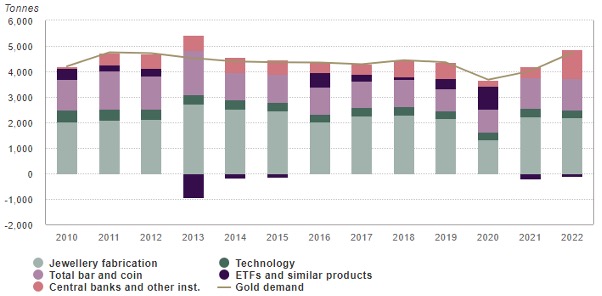
Gold as a strategic asset class or a tactical play?
Some portfolio managers use gold as a strategic asset class by allocating a decent pie of the portfolio to it for the long-term to get diversification benefit. Studies shows that investing between 2% to 10% of your balanced portfolio in gold produce higher risk-adjusted returns over the long-term. However, sometimes, gold can also be used tactically against the behaviour of the dollar movements and bonds’ yield curve. Gold generally performs well when dollar is depreciating against other major currencies and bonds’ yields are falling, and vice versa. At Simply Ethical, all our portfolios consist of gold as a strategic asset class, however, the allocation to gold varies based on each portfolio profile and also tactical aspects.
Use of gold in a balanced investment portfolio: Strategic vs Tactical
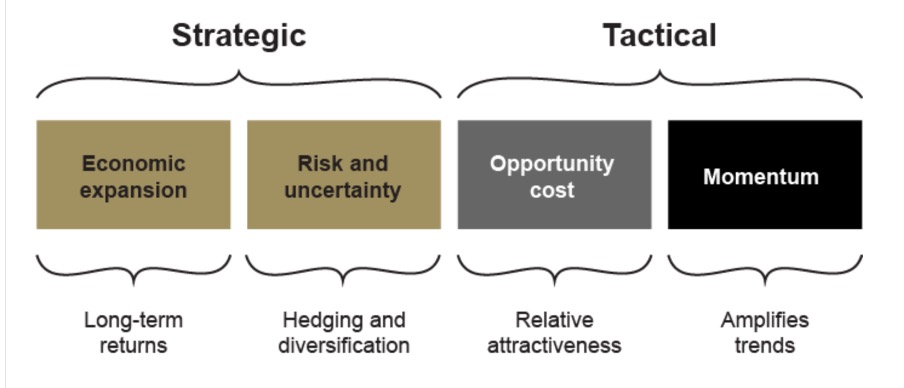
Gold generally has negative correlation with real interest rates, providing positive returns when real rates are falling and vice versa, as shown in the graph below. The market expectations are that the Fed will reduce interest rates in 2024 (or possibly late end of this year) and beyond after possibly some monetary tightening during this year due to high inflation, if that happens, that could be a positive development for gold investment. However, there are a number of factors at play when it comes to investing in gold, hence, prudence is required particularly at entry points i.e., when investing in gold. We have seen the recent upside in gold prices, mainly due to adverse news from the banking sector.
Gold (yellow) vs Real Rates (blue)
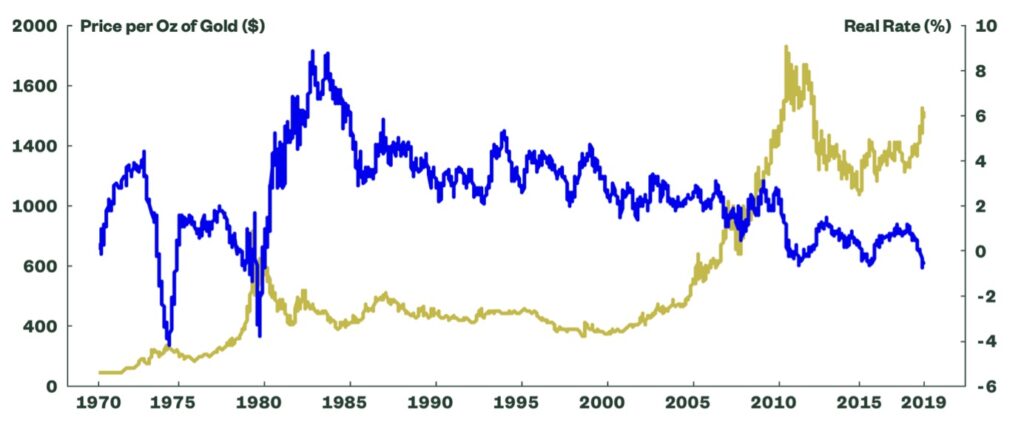
Gold as a portfolio diversifier and a safe-haven asset
Precious metals like gold are less sensitive to the health of the economy due to their modest use in the industry and consequently are less correlated with traditional asset classes, i.e., stocks and bonds as shown below. (figures 2 and 3 below). The asset that has negative correlation with other assets provides a natural hedge. Gold is considered a safe-haven asset as it exhibits hedging properties during extreme market volatilities. Investors prefer to allocate their funds to gold during financial markets turmoil because gold generally tends to maintain its value during tough times. Moreover, a low correlation between different asset classes in a multi-asset/balanced portfolio can potentially enhance diversification and improve the overall risk-adjusted return of the portfolio.
Gold correlation with Equity Markets
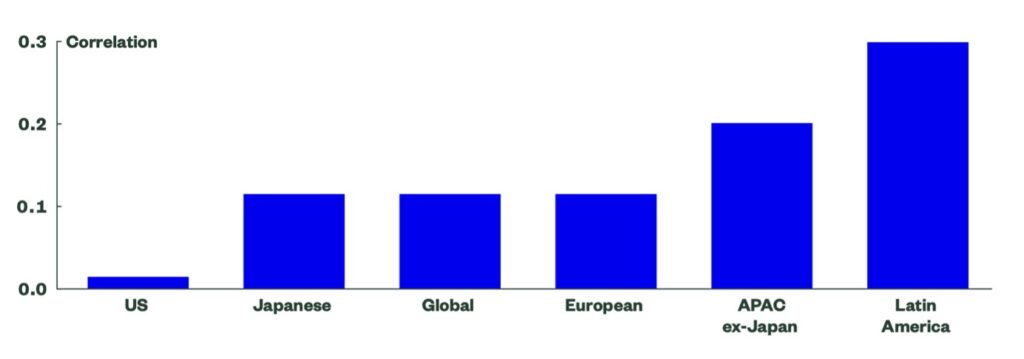
Gold correlation with Bond Markets
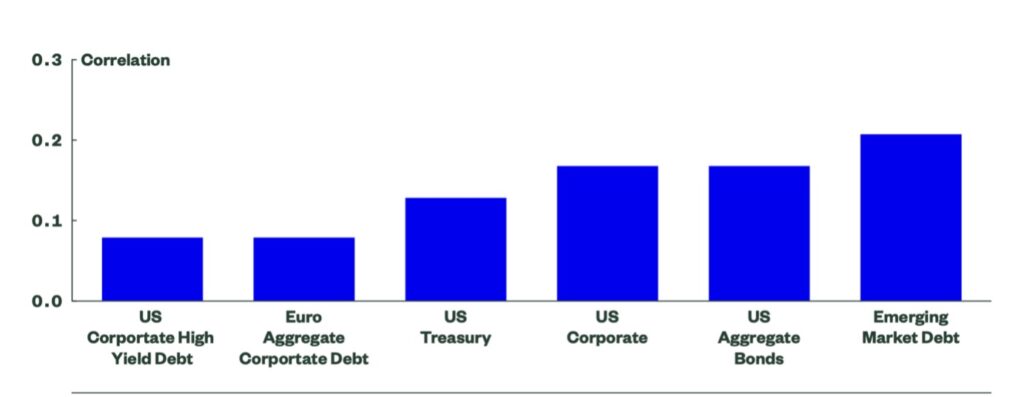
Given that gold provides diversification benefits in the investment portfolio in addition to serving as a safe-haven asset, therefore, it is a good hedge against the tail risks (Tail risk is the financial risk of an asset or portfolio of assets moving more than three standard deviations from its current price, above the risk predicted by the normal distribution). Whenever financial markets have fallen significantly, most of the times gold has provided positive returns, as demonstrated in the figure below.
Gold price returns (yellow) vs S&P 500 total returns (blue)
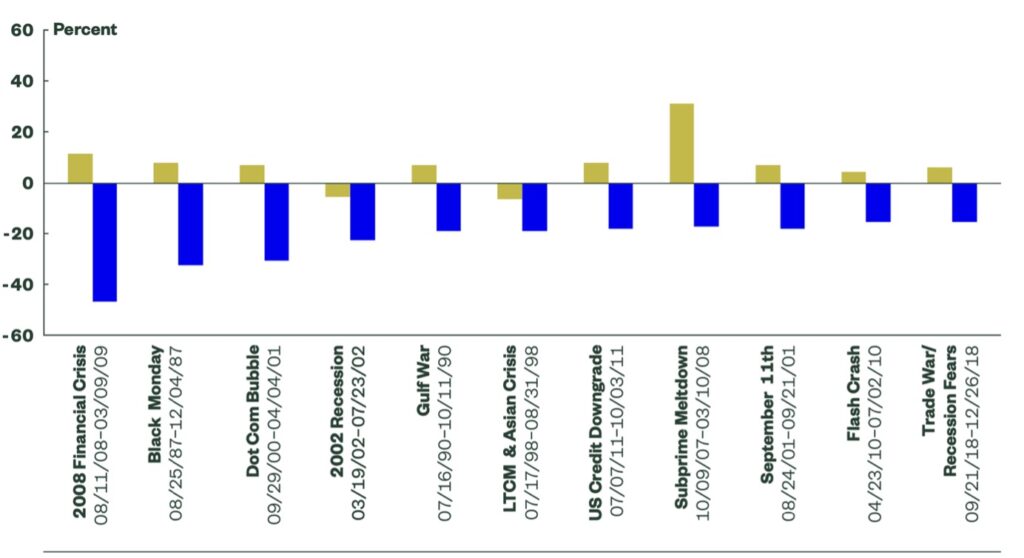
Gold provides an Inflation hedge
Gold is perceived to maintain its value during periods of high inflation. Gold generally performs well during heightened inflationary periods as shown below. Historically, gold’s characteristic as a store of value may be driven by its capability to preserve purchasing power over time by hedging both price inflation and currency devaluation.
Gold returns in different inflation scenarios
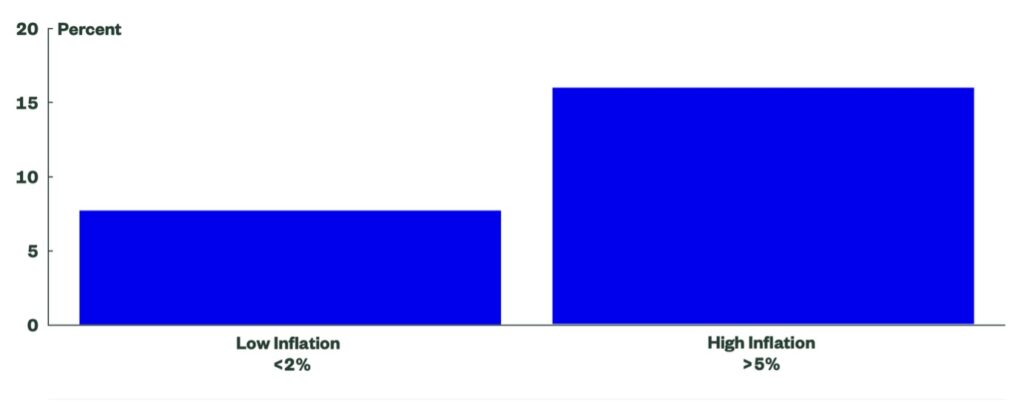
It is worth to note that gold’s role as a portfolio diversifier and inflation hedge are two highly ranked motivations to include gold in your investment portfolio, as highlighted in chart below. However, its role as a return generator or liquidity provider in the portfolio are ranked lower.
Most valued attributes of gold investment
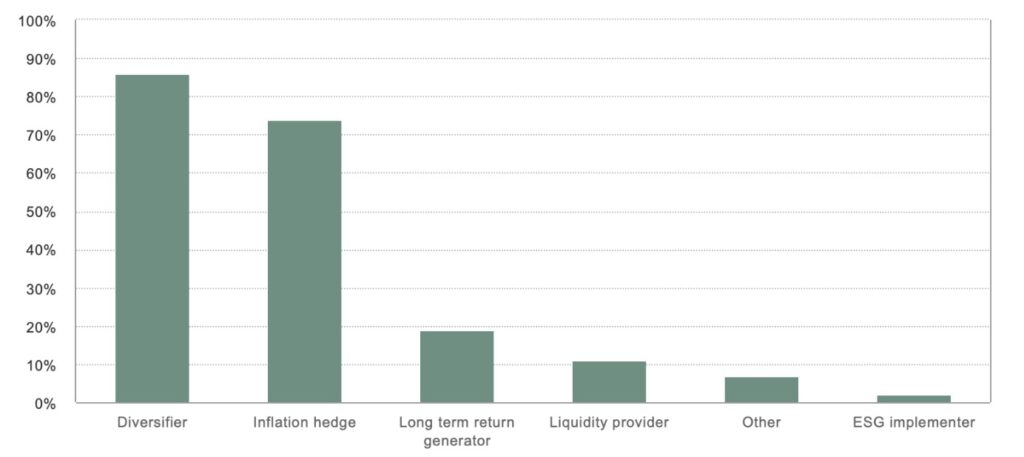
Ways to invest in Gold
There are different ways of investing in gold and investors can choose the most appropriate way for them. At Simply Ethical, we gain exposure to gold primarily through ETFs which hold physical gold. The ETFs we use are certified as Sharia compliant. Moreover, for those with bespoke portfolios we also invest in listed gold mining companies. Investing in individual companies can be more volatile than the gold price itself due to company-specific risks in addition of broader market risks.
Although gold has low to negative correlation with traditional asset classes and is considered a safe-haven asset, however, gold does not provide any cash flows. Its value only comes from the price appreciation, if any. Therefore, entry point (i.e., when to buy and at what price?) into gold becomes critical. At times, gold can have positive correlation with stocks and bonds, making it less useful as a portfolio diversifier asset class. Despite these drawbacks, gold has mostly proven be an asset that offers diversification benefits, protects against inflation or currency devaluation and, moreover, it can deliver positive returns for long term patient investors.
To learn more about how we can help you, book a free initial consultation with one of our Financial Advisers.
Disclaimer
This article is for information only. Please do not act based on anything you might read in this article. Past performance is not a reliable indicator of current or future returns. This article contains general information only and does not consider individual objectives, taxation position or financial needs. Nor does this constitute a recommendation of the suitability of any investment strategy for a particular investor. It is not an offer to buy or sell or a solicitation of an offer to buy or sell any security or instrument or to participate in any trading strategy to any person in any jurisdiction in which such an offer or solicitation is not authorised or to any person to whom it would be unlawful to market such an offer or solicitation.
When you access a shared link of third-party websites, you are leaving our website and assume total responsibility and risk for your use of the third-party websites. We make no representation as to the completeness or accuracy of information provided at these websites nor do we endorse the content and information contained on those sites.

